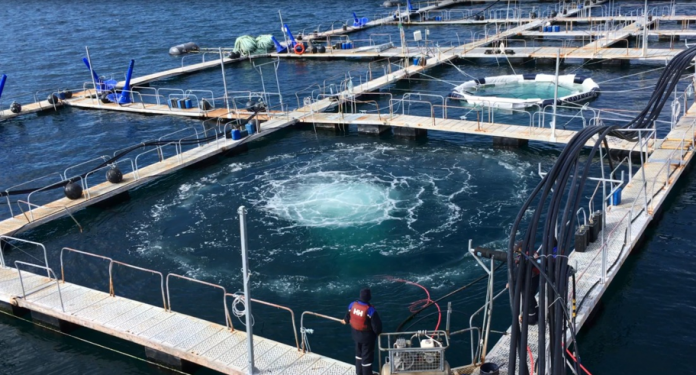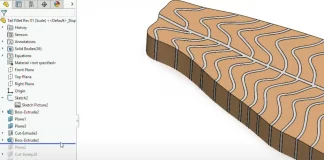A well-known problem in late summer and during the autumn are algae blooms, which creates unfavourable oxygen conditions in the water. To overcome this challenge, Vard Aqua Sunndal, a supplier to the industry, believes that fish farmers should use their upwelling system upstream, which lifts fresh and lice-free water up the cage.
Especially when using lice skirts, there will soon be less water exchange in the upper part of the cage, which leads to low oxygen values and poorer water quality. This means less unnecessary stress for the fish because stressed fish have a poor appetite and a greater likelihood of disease.
Vard Aqua Sunndal believes that their upwelling system provides a clear improvement in water quality and fish health throughout the cage.
“We know that low oxygen levels are a critical issue for fish farmers. That is why we have developed this solution,” says Nils Almvik, Product Manager at Vard Aqua Sunndal.
At the end of August, the system was deployed to a fish farmer.
“We quickly saw a very good effect with large positive changes in oxygen values. By lifting oxygen-rich water from the bottom of the cage, oxygen levels increased by 30 per cent within the lice skirt to the same value as we had under the lice skirt,” says Almvik.

At this production site, ten upstream rings were placed in the centre of each cage at a depth of 15 meters. The oxygen sensor was three metres deep at the outer edge of the cage. The fish farmer uses five meter deep lice skirts in a 160 metre cage. The average fish size was about four kilos and the total biomass was about 600 tonnes.
Better water quality
“Our system ensures that you always have the same water quality in the water up in the lice skirt as below the skirt. If you have poor water quality in the upper layers of the cage, due to algae and lice skirts, and measure better water quality at depth – lifting oxygen-rich and virtually lice-free water from the seabed will provide a flow that provides good circulation and optimal water quality in the cage,” explains Almvik.

Data from the fish farmers show that when fresh water is lifted, the water quality inside the cages with lice skirts becomes as good as outside the lice skirt.
“We get feedback from fish farmers who say that larger water replacements also give less lice spread and better gelling health,” he continues.
Should stand around the clock
The photosynthesis of algae produces, as is known, oxygen when it is bright outside. At night, however, they will consume oxygen in the sea. If you are already struggling with low oxygen levels, darkness will lead to a critical phase for those who breathe underwater.
“The use of the upstream system produces major consequences for the fish farmer, who does not have to worry about low levels after feeding and at night,” says Almvik, who recommends the fish farmers to have the upstream system standing around the clock.
Oxygen Vulkan
Almvik says that the ring moves in excess of 20,000 cubic metres of seawater every hour – which also facilitates the fish getting good exercise.
“We call it a “volcano” and the fish seem to thrive in the oxygen-rich waters. They search inside the air stream and walk up and around the bubble stream like a shoal. With the ring in place in the middle of the cage, in just a few minutes you can measure increased oxygen levels and get an even distribution of oxygen in the cage.”
“Another thing that is special about this ring is that it can be used for oxygen supply if desired. Then you replace the hose with oxygen diffusers and use the same ring,” he says.
Almvik believes that the system makes it very easy to monitor.
“After we install it, no maintenance is required. An air compressor in a ten-foot container on the feed barrel provides enough power and even oxygen distribution to the cages via distributions and hoses. In the container, such a compressor is so quiet that you can hardly hear it,” Almvik elaborates.
According to Almvik, the system is energy efficient and requires a power supply of 3 x 100 amps and 400 volts. The Upwelling ring itself is made of PE plastic, is 1.45 meters in diameter and weighs about 40 kilos. It should make it easy to attach to ideal depth. Two or more ropes keep the ring in place in the middle of the groove and away from the groove walls.
Oxygen conditions are constantly logged and read in Vard Aqua’s cloud solution or the fish farmer’s monitoring systems. The fish farm worker can, by means of a valve, either electrically or manually, shut off one or more rings if necessary.

Can be moved from site to site
Because the cages have different distances from the feed barge, the system is adjusted so that all the hoses have the same oxygen flow to the cages.
“The system is very easy to move from site to site using the work boat. When you slaughter the fish and fallow the site, it’s easy to bring the entire upstream system to another site,” says Almvik.
He says that the system has been in use in Norway over the past year. The system was originally developed by Vard Aqua Chile, which has now been further developed and adapted to the Norwegian market.
“We clearly see that increased circulation and more oxygen have a major effect on water quality. When you get improved fish health and increased growth, it is a good investment,” Almvik believes.










